#15: PEDESTRIANISE THIS!
Ed Jefferson is attempting to visit every Mews in Greater London. This week: horse scams, evil St Bernards, and Guy Ritchie's cursed pub.

This week saw the announcement of yet attempt to pedestrianise London’s Oxford Street - Sadiq Khan being more hopeful about getting his long-standing ambition for the area through under a Labour government, who seem to to be up for giving him new powers to get the plan through without Westminster council gumming up the works.
The issue of motor2 traffic on Oxford Street has been a long-standing one - private vehicles have been banned during the day since 1972, and full pedestrianisation has long been mooted - in the eighties there was a plan to do it by putting the traffic on a flyover running the length of the street, and Ken Livingstone re-proposed the idea in 2006, with a tram to replace the bus routes. Khan’s proposals have got further along, but have so far failed to get anywhere because of stiff opposition from local residents and businesses.
This is nothing new. The idea that a city’s main shopping streets ought to be traffic free gained traction in the middle of the 20th century - initially in Germany (in some cases urban replanning efforts have been ‘pushed through’ with the ‘aid’ of bombs dropped by foreign air forces), but also, surprisingly, in the US. Lots of town planning types in the UK thought it was probably a very good idea, but failed to get anywhere because of the far more popular idea of “BRRRM BRRRM DRIVE MY CAR EVERYWHERE”.
Then, in 1964, a sewer collapsed in Norwich. The road above had to be closed to traffic for six weeks, and the shopkeepers were stunned to discover that trade was either unaffected, or went up. It was permanently pedestrianised, with a ceremony in which the Lord Mayor and his wife tied a white ribbon across the street - a charming detail that belies the fact that it was viewed as closing a street to traffic rather than opening it to pedestrians. By 1970 there were 20 such schemes in the UK - by the early 1980s there were over 100.
And more or less every single time you see the same pattern - local traders are convinced it’ll destroy their business, local residents predict TRAFFIC HELL, and yet decades later the idea that these city centres were ever not pedestrianised is unimaginable. There is a complete delusion around the importance of being able to drive a car to the exact place you’ll need to be in an urban centre, and especially so in London. I’ve heard a shopkeeper bemoan the impact a Low Traffic Neighbourhood was going to have on their business in Angel.
To be fair, there are examples where pedestrianised streets have failed - particularly in the US, where a lot of the ‘pedestrian malls’ installed in the ‘60s and ‘70s were “demalled” in the following decades, or some cases just completely collapsed as viable shopping streets. In the UK, Bridgend in Wales has debated undoing the pedestrianisation that was put in in 2004, under pressure from, as usual, local businesses, who say they are struggling. And I believe them when they say they’re struggling.
But the thing is, traffic restrictions are not the only the thing that happens in the world. City centres, pedestrianised or not, have had to deal with competition out of town shopping centres3, and the internet, and economic crises, and commercial landlords charging ever more obscene amounts of rent, and COVID, and god knows what else next. There seems to be a complete mental block for some people where they can only ever believe the consequences of traffic restrictions can be negative, and that anything negative that happens must be to do with traffic restrictions. I heard the Thirty Years War only happened because the King of Bohemia tried to put in a one way system on the ring road.
The case of Oxford Street is of course, slightly different, because it’s been closed to private vehicles for decades anyway - though, having lived in lots of parts of London, including some fairly central ones, I can’t recall ever having had the thought: “It would be bad if they redirected buses so more of them stopped on my street.”4
Mostly the objections demonstrate, I think, the same failure of imagination that dogs so many of these schemes that are, ultimately, intended to make life slightly more bearable. Things will change, and there will be problems that have to be dealt with: but that will happen anyway, whatever you do: because you exist in the world!
Anyway, my advice to anyone living in the West End who is appalled at the idea of a pedestrianised Oxford Street is that they should give their home to me, for free. Sadiq Khan would really hate that, and it is time to teach him a lesson.
The Mewses
#141 Tottenham Mews, Camden, W1T
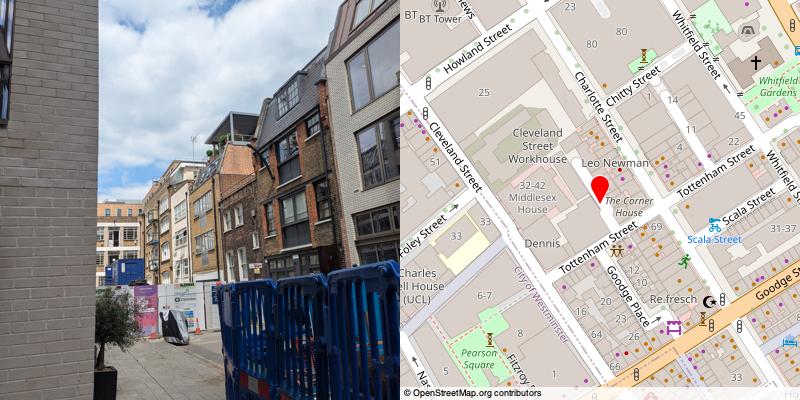
Neither this, Tottenham Street, nor Tottenham Court Road are named after Tottenham in North London, and that is apparently just a coincidence. What the fuck?
Seems to feature in the debut novel of someone called Mark Bowles, though it isn’t released next week so I have no idea what it’s about if it’s any good. Good luck to Mark and all authors who incorporate Mewses into their novels (unless JK Rowling’s done it).
#142 Charlotte Mews, Camden, W1T
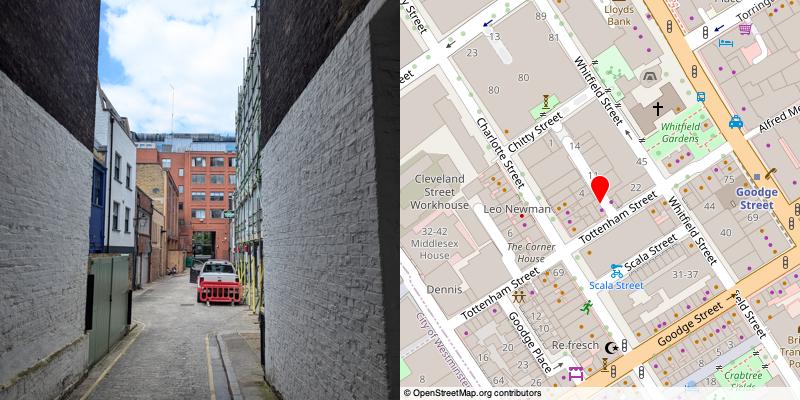
Because George the third’s wife was called Charlotte. Suspect no-one really thought through the logic here - naming the street after the Queen: nice, respectful; naming the mews behind, where the horses piss and shit, after the Queen: hmm.5
There was a Victorian-era poet called Charlotte Mew who at one point live just around the corner in Charlotte Street, which must have been weird. Would I move near a street called Ed Jefferso? I think I’d be suspicious, at the very least.
#143 Alfred Mews, Camden, W1T
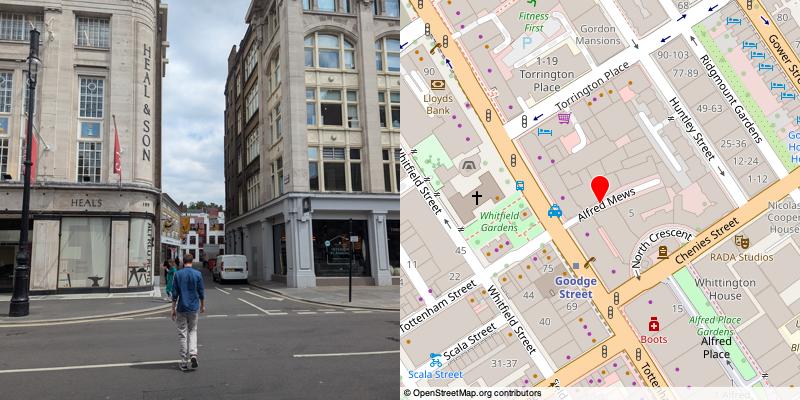
Principally used as as service access for the enormous building to the north, built for, and still partly occupied by, Heal’s, the 200 year old swanky furniture retailer. After the death of founder John Harris Heal in 1833, his widow took over and renamed the company after herself - it is posterity’s loss that the name Fanny Heal & Son didn’t stick.
#144 Chenies Mews, Camden, WC1E
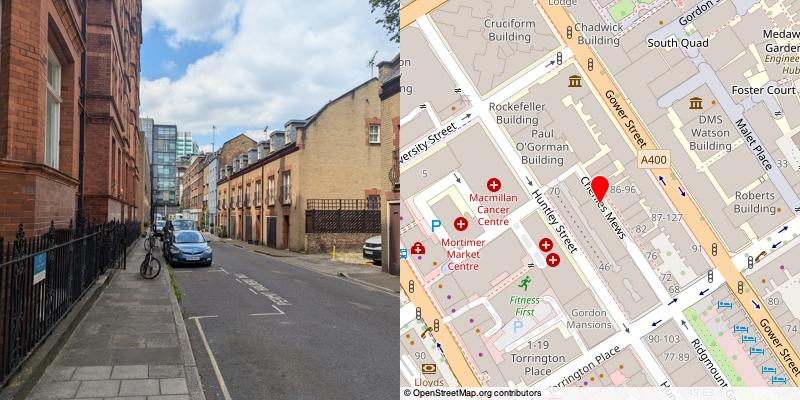
Be wary if buying a horse here - in 1834, Julian Charles Young, son of once noted ‘tragedian’ actor (i.e. played Hamlet and similar sadsacks) Charles Mayne Young, fell for an extremely clever horse scam in which he paid a man for the horse and then the man didn’t give him the horse. He relates this in what is ostensibly a memoir about his father - you get the feeling that he ran out of stuff to stay about dad pretty quickly and had to fill for the remaining 400 pages. Ah well, we’ve all been there.
These days instead of stables it has a state of the art medical Imaging Centre - I guess if you are worried about buying a dodgy horse you can ask them to scan it for you first.
#145 Howland Mews East, Camden, W1P

The ‘East’ part is now somewhat redundant, Howland Mews West having disappeared under the Sainsbury Wellcome Centre for Neural Circuits and Behaviour, part of University College London that studies Neural Circuits and Behaviour, I expect. The survivor of the pair is service access for the buildings on the surrounding streets, including various other bits of UCL that have leaked over from the other side of Tottenham Court Road over the years. I hear these days if you don’t get a degree in DEI they shoot you with a gun.
#146 Cleveland Mews, Camden, W1T
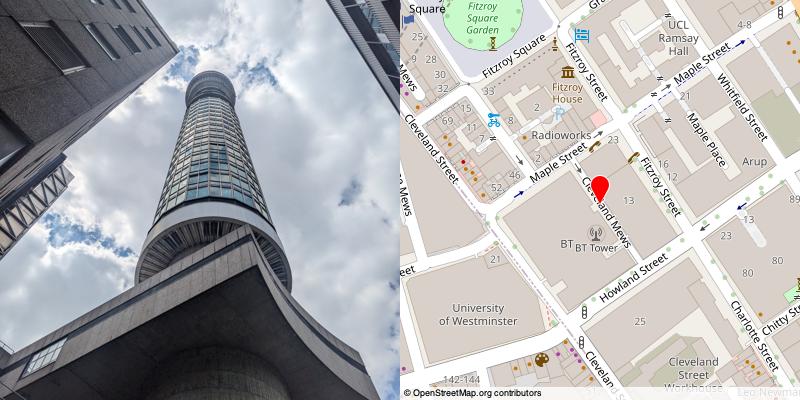
Home to possibly the largest building in any Mews I’ve visited so far6, the BT Tower - the GPO/Post Office tower for the antiquated/performative (it is usually listed as having a Maple Street address, but Historic England, who have given it a Grade II listing, say the statutory address is Cleveland Mews, which is good enough for me).
The tower was constructed in the early 1960s, when it was correctly anticipated that that very tall buildings were going to become more common in London, which was a problem if you wanted to beam microwave communication signals around the place without them bouncing off stuff. So they built a nearly 600 metre high tower to hang their aerials off.
It was opened in 1965 by PM Harold Wilson, and then opened again, to the public, in 1966 by Tony Benn (then postmaster), the Queen (then the Queen) and, er, Billy Butlin? Billy was present because Butlin’s, his holiday camp company, was responsible for running a revolving restaurant on the 34th floor, which should really still be a wonder of the city, but lasted barely 5 years: the building was closed to the public in 1971 after some members of the public (it’s unclear whether they were part of an anarchist collective or the IRA) decided to blow up the men’s toilets in said restaurant.
Information about the tower has technically been classed as Official Secret, leading various fools over the years (including Baroness and twat Kate Hoey, in parliament) to state that it can’t be shown on Ordnance Survey maps, a fun fact which does not survive contact with say, looking at an Ordnance Survey map.
The Mews itself is named for the Duchess of Cleveland, who gained the title by shagging Kings Charles II - and to think, my mistresses have to make do with a box of milk tray! In 1881 it was home to a St Bernard dog who "amused itself by springing upon women, and attempting to worry them", which is probably in practice less funny than it sounds.
#147 Conway Mews, Camden, W1T

Another of Camden’s ‘pub mewses’, this time running beside/beneath the ‘Lore of the Land’, which is owned by Guy Ritchie and appears in his okayish if you like that sort of thing film ‘The Gentleman’- there is an unsettling movie set gloss about the place that makes you long for the days when it was an O’Neills (maybe the pub Gods agree - it’s somehow managed to go on fire twice since Ritchie bought it). Alan McGee funded the early days of Creation Records (Primal Scream, Oasis et al) by running gigs in the pub’s upstairs room, back when it was called The Adams Arms.
Since the 1970s the Mews has been occupied by a mixed use block (an accountancy college with some flats above it, called ‘County House’ for no readily obvious reason) set at an angle to the surrounding streets - presumably this was to maximise space, but it gives it the impression of something that isn’t supposed to be there and might take off again at any moment.
#148 Fitzroy Mews, Camden, W1T
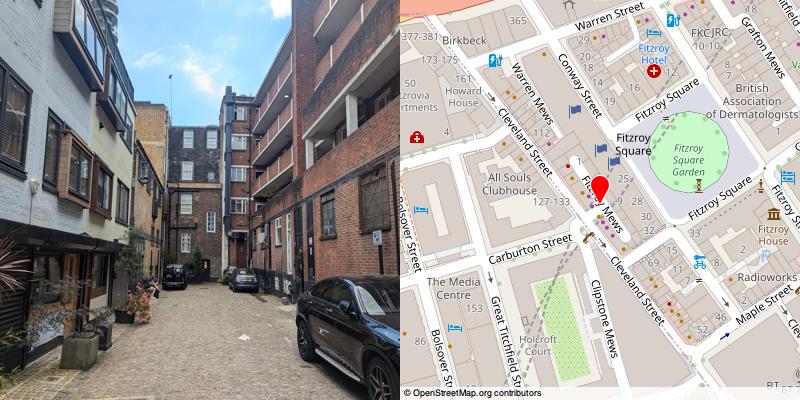
Fitzroy was often given as a surname to (recognised) illegitimate sons of kings, as it literally means “son of the King” in Anglo-Norman. Was the idea that the non-Anglo-Norman speaking plebs wouldn’t be able to crack the code to find out that the King couldn’t keep it in his pants?
Anyway, in this case it refers to Henry Fitzroy, the son of Charles II and the Duchess of Cleveland (see Cleveland Mews above)- he and his descendants owned much of the land in this area, hence various streets called Fitzroy [something]. The wider area is now generally called Fitzrovia, after local boozer The Fitzroy Tavern7; there is some vagueness about when the name Fitzrovia came into general use - it was coined in the 1930s in reference to various artists and bohemians who hung out in the area, i.e. in the pub, but doesn’t seem to have really settled until the 1970s, when it stuck despite subsequent inexplicable attempts to rebrand it as ‘NoHo’.
#149 Warren Mews, Camden, W1T
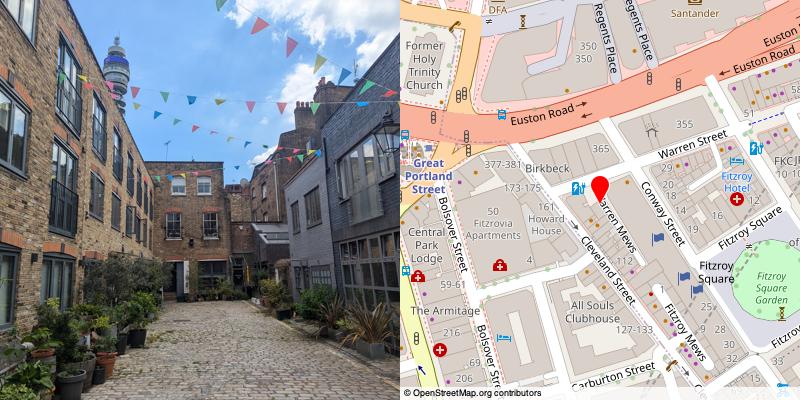
At the time of my visit was covered in bunting that I assume was in aid of it having been part of the National Garden Scheme, where in return for a charitable donation you can wander round a garden. Not to do down a charitable endeavour but despite the best efforts of the National Garden Scheme website to spin it (“On first glance, it is impossible to tell that the plants in this verdant garden have no access to the earth.” - maybe if you’ve lost your glasses, mate), this isn’t actually a garden, is it? Grow up.
#150 Richardson's Mews, Camden, W1T
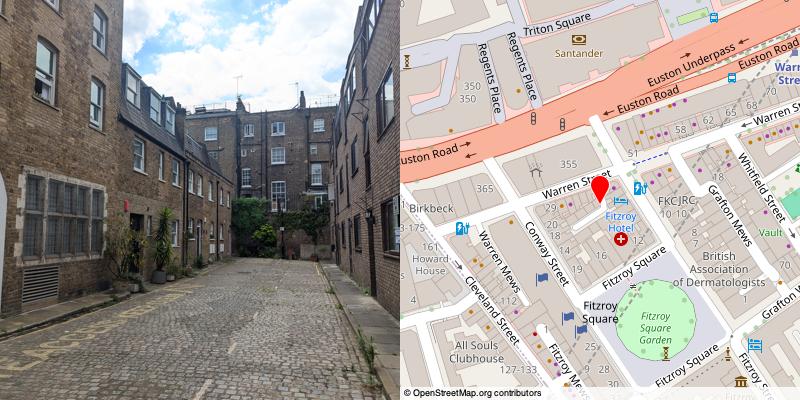
Hmm, you know how I said it would be weird if there was a street called Ed Jefferso? Well this isn’t called that obviously, but my dad was called Richard. SPOOKY.
Mewses Visited Thus Far: 150/2380

Though this is sarcasm this year they did elect their first not a Tory MP (a Lib Dem) for about a century, so baby steps. ↩
Well, and other kinds - e.g. rickshaws and other wheeled tourist scams. ↩
Though why can’t I drive my car through the Westfield shopping centre, anyway? Don’t I have human rights? ↩
Accessibility is, obviously, a very important consideration, but is a more nuanced issue than is sometimes presented by those opposed to traffic measures - though reducing motor vehicle access can be an issue for some, it also increases the space available for e.g. wheelchair users. ↩
I think I’ve made this observation before but I’m not going to check. ↩
Most likely it’s the tallest in any Mews, though there are 22 buildings taller than it in the UK now, some of which might also be ‘on’ Mewses through addressing technicalities. ↩
For some decades this was the home of a monthly meeting of Doctor Who nerds, though they decamped somewhere else for a while the interior was being restored to the original extremely annoying Victorian layout of being about 200 separate awkwardly tiny rooms and I’m not clear if they ever went back. Anyway, worth a shot if you want to talk to a lunatic about Daleks while drinking very shit beer. ↩
-
Completely agree about the refurb in the Fitzroy... My entirely fact-free theory is Humphrey did it so he didn't have to put a proper accessible loo in. Ended up, accidentally, at the Dr Who meet up once, in the dark times, and met Stephen Moffatt. Was too starstruck to ask him about Press Gang...
Add a comment: